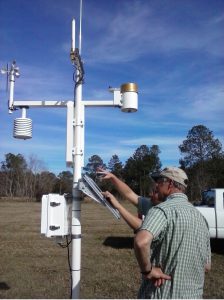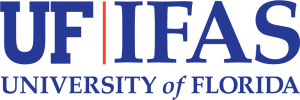The Challenge of Weather in Agriculture
“Everybody talks about the weather, but nobody does anything about it” is a famous quote that has been around for many years. Although we still cannot modify the weather to fit the needs of our crops and livestock, we can develop strategies and decision support tools to help producers better adapt to expected weather patterns and reduce the risks associated with climate variability and change.
Agricultural producers around the globe depend on the weather pattern for an entire season, an entire year, or even longer periods of time, to ensure the sustainability of their operations. Florida’s sunny climate and its generous rainfall make it ideal for agriculture, and indeed, about a quarter of Florida’s land is devoted to growing food crops, landscape plants, and ornamentals. For example, Florida is the top U.S. producer of fresh market tomatoes, sugarcane, and ornamental fish. But Florida ranks high, if, not first, in a host of other products, from sod to strawberries, cut flowers, and of course the state’s signature product, citrus.

Nevertheless, producers in Florida and around the world are challenged to increase yields while increasing resource use efficiency and reducing environmental impacts. The sustainable intensification of production systems is by itself a significant challenge that is greatly enhanced when compounded with the expected increase in the occurrence and intensity of weather extreme events due to climate change. The recent Intergovernmental Panel on Climate Change (IPCC) Sixth Assessment report states that larger economic losses are observed for sectors with high climate exposure, including regional losses to agriculture and forestry due to impacts on crop yields, water availability, and outdoor labor productivity due to heat stress.
Florida Climate Institute’s Contribution
There is an urgent need to provide the agricultural industry with tools and information to reduce risk and attain the required production increase to feed a growing population. This is exactly the problem that Clyde Fraisse, professor at the University of Florida Agricultural and Biological Engineering department, and his colleagues began to address almost 20 years ago when agricultural and meteorological experts joined to a group that would become the Florida Climate Institute (FCI). Bringing together the latest in climate and crop modeling, FCI has produced a continuing and expanding range of research as well as researched-base management tools that are affecting agricultural practice around the world. The main goal of Fraisse’s AgroClimate program is to develop and apply methodologies, including empirical and process-based mechanistic models as well as machine learning algorithms to help incorporate climate and weather information into agricultural producers’ decision-making process. Basically, it aims at increasing action on, and value of, climate and weather information by developing predictive and prescriptive analytics solutions for the industry.
While Fraisse’s work involves climate and weather forecasting and mathematical modeling, it also involves making all of this understandable and accessible to Florida agricultural producers. In years of working with producers, Fraisse has developed a deep understanding of the challenges and needs in the production of many crops. Working with his colleagues at FCI, a series of online platforms have been created – AgroClimate.org – which can be accessed by anyone whenever it is convenient. Thus, producers have a “climate advisor” available 24/7. This is critical because a gradual, but steady, rise in annual temperatures and in sea level are changing Florida’s climate. These changes are happening around the world, and scientists like Fraisse are working hard to give agricultural producers an advantage in preparing for these changes.
Global Impact and Future Directions

In addition to the overall warming trend, there are important climate cycles in seemingly remote places that also have an effect on Florida’s climate. The most famous of these is the El Niño–Southern Oscillation (ENSO), which is a warming of ocean waters in the eastern equatorial Pacific Ocean. This phenomenon was first identified in the early 20th century, but it was in the late 20th century that its links to global climate patterns were first established. It was found that from year to year the water in this region of the Pacific can be warmer than normal, producing an El Niño event, or cooler, producing a La Niña event. There are also “neutral” years when the water temperature remains close to normal.
El Niño years in Florida tend to be cool and La Niña years tend to be warm between October and April. Although the influence on rainfall is spatially less consistent, El Niño years tend to be wet and La Niña years dry during these months. The ENSO signal in the region is strongest in the fall and winter months but some evidence exists that La Niña summers tend to be slightly wetter than normal. El Niño or La Niña can only be predicted a few months in advance, but tools developed by Fraisse and FCI update producers regularly and let them know as soon as one of these events is confirmed and what its intensity is likely to be. Producers in Florida can benefit of this detailed information about what to expect in the coming growing season.
A few recent examples will show how Fraisse and colleagues are helping to make climate information more practical and useful than ever:
- Developing online disease alert systems to help strawberry and blueberry growers spray fungicide only when environmental conditions are favorable for disease development
- Developing chill accumulation calculators to help temperate fruit growers. Monitoring of winter chill is required to determine the suitability of a cultivar to a particular growing region, to determine the timing of management practices such as applying dormancy-breaking chemicals, and to predict yield potential.
- Developing weather index-based insurance to cover losses due to drought for soybean in the southeast U.S.
- Developing a fusarium wilt risk calculator that can help watermelon growers estimate the climate-based risk of a fungal infection
- Developing an integrated approach to climate adaptation and mitigation for processed potato and tomato.
The work Fraisse and FCI is now being adopted internationally. The announcement of Fraisse receiving the UF-IFAS International Achievement Award describes the extent of this adoption. The AgroClimate system is being adapted by workers in Africa and Latin America. Fraisse is a member of the World Meteorological Organization (WMO) Standing Committee on Services for Agriculture (SC-AGR) Expert Team in Agricultural Capacity Development and has consulted widely both in the U.S. and abroad about the use of climate tools to improve agricultural production. Fraisse is assisting worker-owned Paraguayan cooperatives in implementing AgroClimate in that country. He was selected by the government of Jordan to assist them in complying with the United Nations’ Rio conventions to address biodiversity, climate change, and desertification. Fraisse is also collaborating with the World Bank in the development of smart climate tools for Kenyan and Ethiopian farmers.
Securing the food supply for the world’s growing population in the face of climate change is important work. Understanding the interactions of crops and climate has many applications and almost unlimited potential. Clyde Fraisse is working to realize that potential for as many as possible.
That’s UF ABE: Big Questions, Global Reach!
This article was written by: Charles Brown
 0
0


